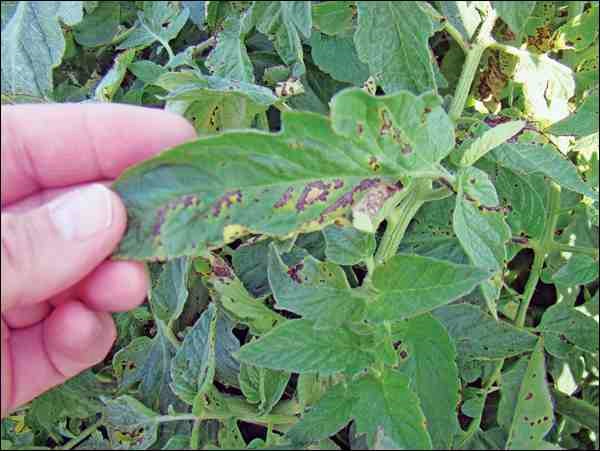To me, the taste of summer is fresh tomatoes in a salad, sandwich or soup - I will even eat them whole, straight from the garden. And, for the most part, tomatoes are relatively easy to grow. However, there are a few challenges along the way. One common problem is early blight.
A couple of weeks ago, I overheard one of my community garden neighbours complaining to a friend that she had noticed it on her tomatoes. I was in a hurry harvesting Swiss chard for supper, so I didn't have time to stop to confirm the diagnosis. But in case you're wondering, it is a fungal disease caused by Alternaria solani, a common tomato and potato foliar disease. Yields are lower due to reduced plant vigour, sunscald on the fruit and occasionally by infected fruit.
This disease can be present at all stages of plant growth from seedling to harvest. Leaf lesions are the most common symptom but the fungus may also cause damping off, collar rot, stem cankers and fruit rot. Circular or angular lesions (up to 1/2 inch in diameter) with dark concentric circles initially form on the lower, older leaves. [Note: bacterial leaf spot produces similar-sized lesions, but without the concentric circles.] The lesions may grow in size, turn entirely black and join together. Infected leaves eventually turn yellow, wither, die and fall off. Once infected, the disease progresses upward to younger growth. High humidity and moderate temperatures (18-30 C) promote disease development.
As one might expect from the name, early blight shows up early in the season (July).
The disease can over winter as spores on infected plant debris from previous years or be present on the seed to start with. Spores can be transported over large distances by wind and spread by insects, other animals (including us) and equipment.
The best strategy to combat early blight is prevention.
Start with fresh, clean seed. If collecting your own seed from open pollinated cultivars (e.g. heirlooms), make sure the fruit is disease-free.
Grow early blight resistant cultivars (e.g. Juliet, Legend, Manyel, Old Brooks, Tommy Toe, etc.).
Remove all plant debris at the end of the season.
Rototill to promote spore breakdown by soil microorganisms.
Rotate crops to break the disease cycle: no potatoes or tomatoes for three years in the same area.
Give plants lots of room to promote good air circulation (= lower humidity).
Stake plants to raise the leaves and fruit off the ground.
Water early in the day to allow water on leaves to evaporate - better yet, use trickle irrigation (e.g. use a weeping hose).
Maintain maximum plant vigour with good nutrition, adequate/timely water and weed control.
Minimize plant damage and spread of spores by controlling insects.
Do not work in a wet garden.
Use organic (compost, grass clippings, newspaper, etc.) or plastic mulch to prevent soil splash. Mulch has the additional benefits of conserving soil moisture and preventing weed growth.
Once you have an infection, control is trickier. Removing infected leaves can slow down the disease progression. Make sure to wash your hands after touching infected leaves to prevent spreading the disease further. According to Health Canada, there are a few early blight control products available to home gardeners. Combination products containing carbaryl (insecticide) and copper (fungicide) control both insects and fungal diseases such as blights (e.g. Wilson Garden Doctor Insecticide-Fungicide; King PTV Potato & Vegetable Dust for Bugs and Blights). Copper-only products (e.g. King Eco-Way PTV Potato, Tomato and Vegetable Fungicide Spray; Bordeaux mixture - available as Bordo Copper Spray [Note: Bordeaux mixture is an organic control certified by the Organic Materials Review Institute]) can be used to prevent early blight and other fungal disease establishment and/or spread. Always follow label instructions for application and personal precautions - this applies to organic controls as well!
Have a gardening question? Contact GardenLine, 306-966-5865 or gardenline@usask.ca
- This column is provided courtesy of the Saskatchewan Perennial Society (www.saskperennial.ca; hortscene@yahoo.com). Check out our Bulletin Board or Calendar for upcoming horticulture events (Labour&Learn at the Forestry Farm; garden tours).



